Cannabinoid Hyperemesis Syndrome (CHS) Explained
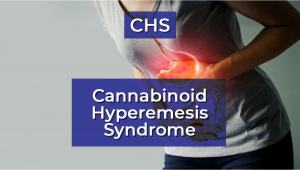
- 1. What is cannabinoid hyperemesis syndrome or chs?
- 2. Identifying the symptoms of cannabinoid hyperemesis syndrome
- 2. a. The problem with legalization and shaming regarding marijuana use
- 3. Cannabinoid hyperemesis syndrome diagnosis and statistics
- 3. a. Cannabis use stats in the u.s. and chs
- 3. b. How can cannabinoid hyperemesis syndrome be diagnosed?
- 4. Why would marijuana cause cannabinoid hyperemesis syndrome?
- 4. a. Opposed thoughts on existing theories
- 5. What treatments are there for cannabinoid hyperemesis syndrome?
- 5. a. Why do hot showers help ease chs?
- 6. Is cannabis hyperemesis syndrome actually new?
- 7. The bottom line
What happens when the treatment to your condition becomes the condition itself? Recent studies have found that the severe long-term use of marijuana could be leading to a disorder known as Cannabinoid Hyperemesis Syndrome, CHS. While cannabis from a medical point of view has usually been seen as an antiemetic, which means it helps against nausea, these newer studies have actually found a new pattern among patients using medical marijuana in which the exact opposite effect takes place: extreme nausea and vomiting.

So, what's the relation between cannabis use and this extreme vomiting? The answer could be Cannabinoid Hyperemesis Syndrome, although this is such a new condition that more investigations are yet to be done. Let's get into everything there is to know about CHS and untangle all this newly found marijuana-linked disorder is about.
1. What Is Cannabinoid Hyperemesis Syndrome or CHS?
As the name indicates, Cannabinoid Hyperemesis Syndrome, which also goes by the name of Cannabis Hyperemesis Syndrome, is a disorder thought to be caused by the heavy and long-term use or marijuana. 1 Hyperemesis is a term used to refer to cases of extreme vomiting, hyper- meaning extreme in Greek, and -emesis implying vomiting. For instance, some women during pregnancy may encounter a condition known as Hyperemesis gravidarum, which is this case of persistent nausea and severe vomiting, much more than the normal morning sickness. 2
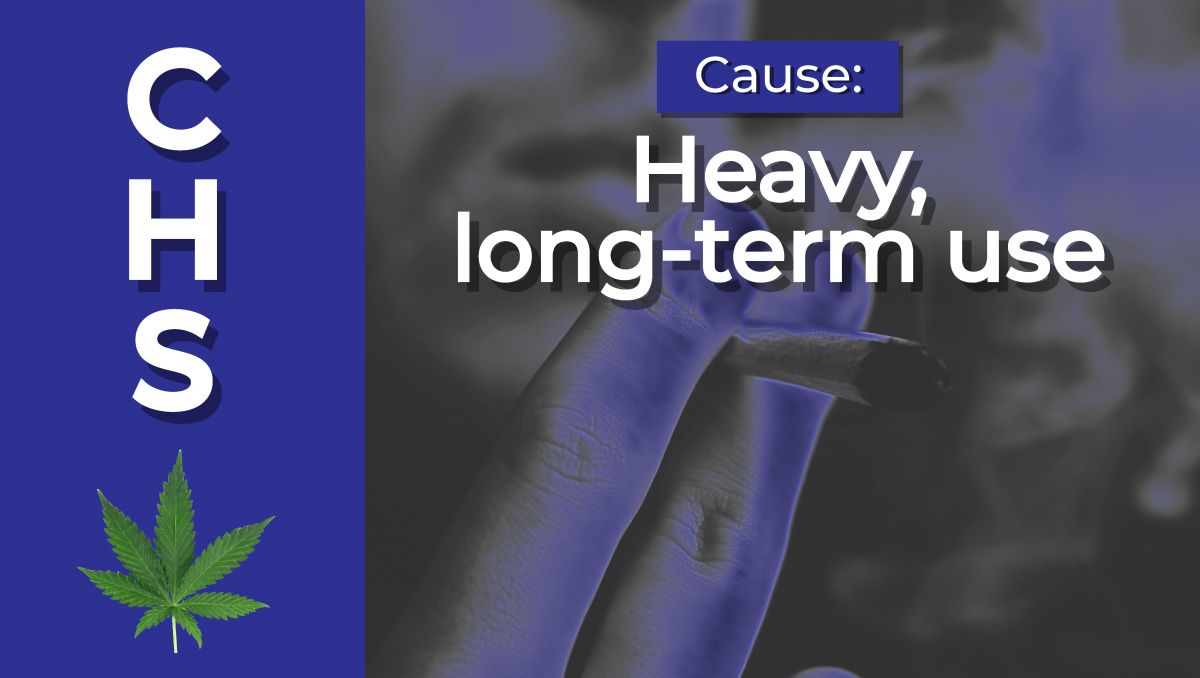
But how come marijuana which is often prescribed to ease symptoms of nausea or vomiting in patients undergoing other medical treatments, such as in cases of CINV, chemotherapy-induced nausea and vomiting in cancer patients, could end up leading to the counter effect?
Well, let's try to identify the symptoms and possible causes of Cannabinoid Hyperemesis Syndrome before we jump to any conclusions.
2. Identifying The Symptoms of Cannabinoid Hyperemesis Syndrome
Just like with any other case of every medical condition ever to exist, the first thing we will need to identify is a pattern of signs and symptoms of the illness. This is precisely the first step a doctor or any other specialist would do when we come to their office asking for their help, they will ask for precisely what we have been feeling or experiencing.
Asking for such information is necessary to try to narrow down the possibilities to this or that condition. When it comes to CHS, the signs and symptoms are divided into three different phases:
|
Stage 1: The Prodromal Phase
|
The prodromal phase may extend for several months or years. During this stage, the main signs include morning sickness and nausea, and abdominal pain. |
|---|---|
|
Stage 2: The Hyperemetic Phase
|
During this phase the episodes of nausea and vomiting become highly repetitive, as it does the abdominal pain. Subjects will most likely seek medical attention and treatment. |
|
Stage 3: The Recovery Phase
|
The condition is finally recognized and diagnosed. Patients who take a break from cannabis consumption will be considered to be in the recovery phase. Vomiting and nausea cease. |
As we've mentioned on the chart above, on the first stage of CHS, the prodromal phase, the subject may be experiencing abnormal pain in the belly area and even early morning vomiting or nausea. However, most people experiencing these symptoms won't yet make modifications to their usual eating patterns. 3
At the same time, since cannabis is often considered an effective treatment for nausea and vomiting, the subjects usually resort to the consumption of different forms of the plant in an attempt to stop the nausea. Another common symptom is developing a fear of vomiting.

During the second stage of the illness, the hyperemetic phase, things become all way too evident to be disregarded. The signs and symptoms during this stage will include:
- Continuous feelings of nausea;
- Repeated episodes of vomiting, even cases of vomiting up to 40 times per house have been reported. 4
- Belly or abdominal pain;
- Changes in feeding patterns, decreased intake of food;
- Notorious weight loss;
- Dehydration and other signs of fluid loss;
- Poor sleeping schedules;
- And abnormal showering or bathing patterns as a measure to ease the symptoms.
At the hyperemetic phase, the vomiting episodes often become deeply intense and may be overwhelming, which then may result in a fear of vomiting. Normally, the subjects suffering from these symptoms will seek medical help at this stage. Once the condition is finally diagnosed by a doctor, the hyperemetic phase will only cease after the patient stops using marijuana in any of its forms. When this is done, the recovery phase will take place.

During this final stage of the disorder, the subject will finally be able to regain their appetite and normalize their feeding schedule. The nausea and vomiting episodes will decrease, even up to completely eradicating the symptoms; body weight may be regained and the showering or bathing regimen can return to normal.
The recovery phase can take days or weeks until changes can be noticed. However, the symptoms often come back when the patient consumes cannabis again. Now, there's one major problem when it comes to the diagnosis and recovery of Cannabinoid Hyperemesis Syndrome and it is one concerning the legal status and social acceptance of marijuana.
The Problem With Legalization And Shaming Regarding Marijuana Use
Although the use of marijuana for medical purposes has been increasingly gaining acceptance in different countries all around the globe, the legalities and the lack of information concerning this substance could be one major obstacle regarding CHS.
In the first place, in those places where the use of cannabis is still not legal, for neither medical nor recreational purposes, users may not open up to their doctors and specialists about their weed use, or the true amounts they use out of fear of what they may judge or do. Besides, since marijuana is thought to ease feelings of nausea and reduce vomiting, the patient may find it irrelevant and unnecessary to talk to their doctor about their frequent and long-term cannabis use, which leads us to the next issue concerning the diagnosis of Cannabinoid Hyperemesis Syndrome.
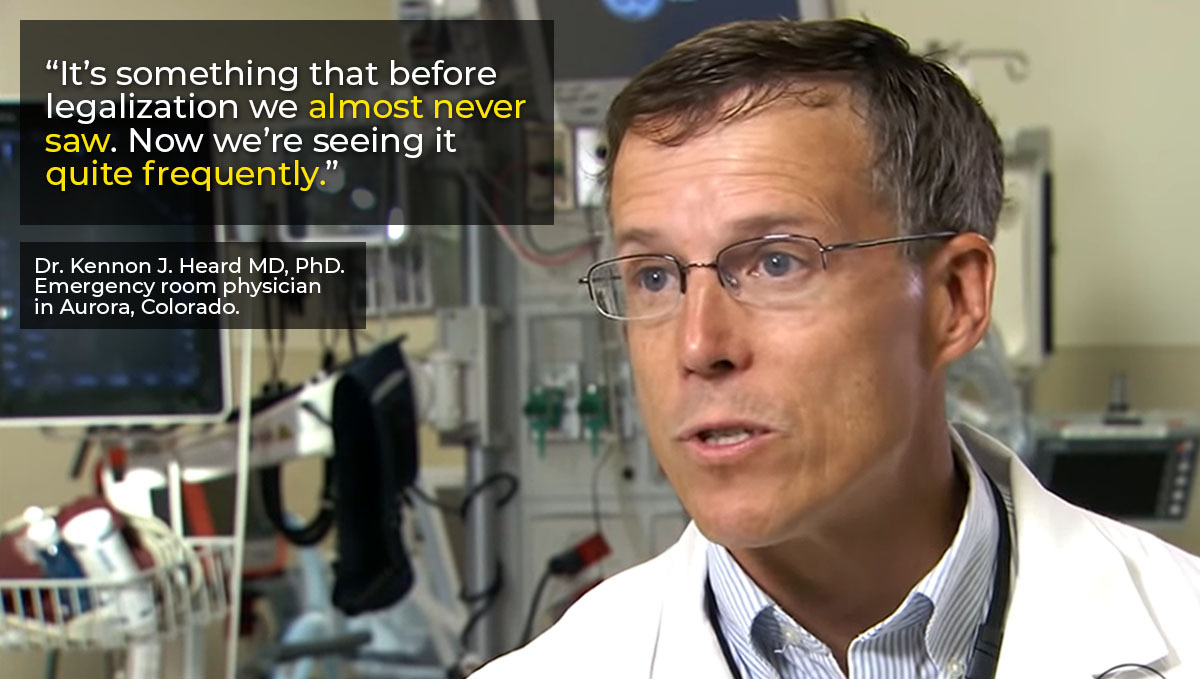
The lack of information and call for investigation focused on marijuana could not be more visible when we look at CHS. Firstly, this is considered to be a somewhat new condition, although we will see further ahead how this is not completely true. And since this is a disorder that is thought to be quite new, or neglected, many doctors are not yet even aware of its existence, therefore, how would they be able to diagnose it for their patients?
The second problem that this lack of information is responsible for is that no real treatments other than hot showers and baths, and ceasing to consume cannabis have yet been found. But again, how will anything ever be found if no one is even searching? Such misinformation could actually lead to greater risks and problems, perhaps there's a major underlying issue that is still unattended.
The call for research on CHS should be soon put into the spotlight. Since now the legalization of marijuana is spreading around the world, the cases of Cannabinoid Hyperemesis Syndrome are already on the rise as more patients are now prescribed to use medical cannabis to treat other medical issues.
3. Cannabinoid Hyperemesis Syndrome Diagnosis and Statistics
Before we get into the different ways in which Cannabis Hyperemesis Syndrome is diagnosed by doctors, let's take a look at some stats and numbers.
Cannabis Use Stats in The U.S. And CHS
The United States began with the legalization of the use of marijuana in the year 2009. After the US Department of Justice had published a memo indicating that neither users nor sellers of medical cannabis would be prosecuted, the numbers regarding marijuana use seemed to increase. However, couldn't this be the result of the liberation for users to open up about their use, rather than an actual use increase?
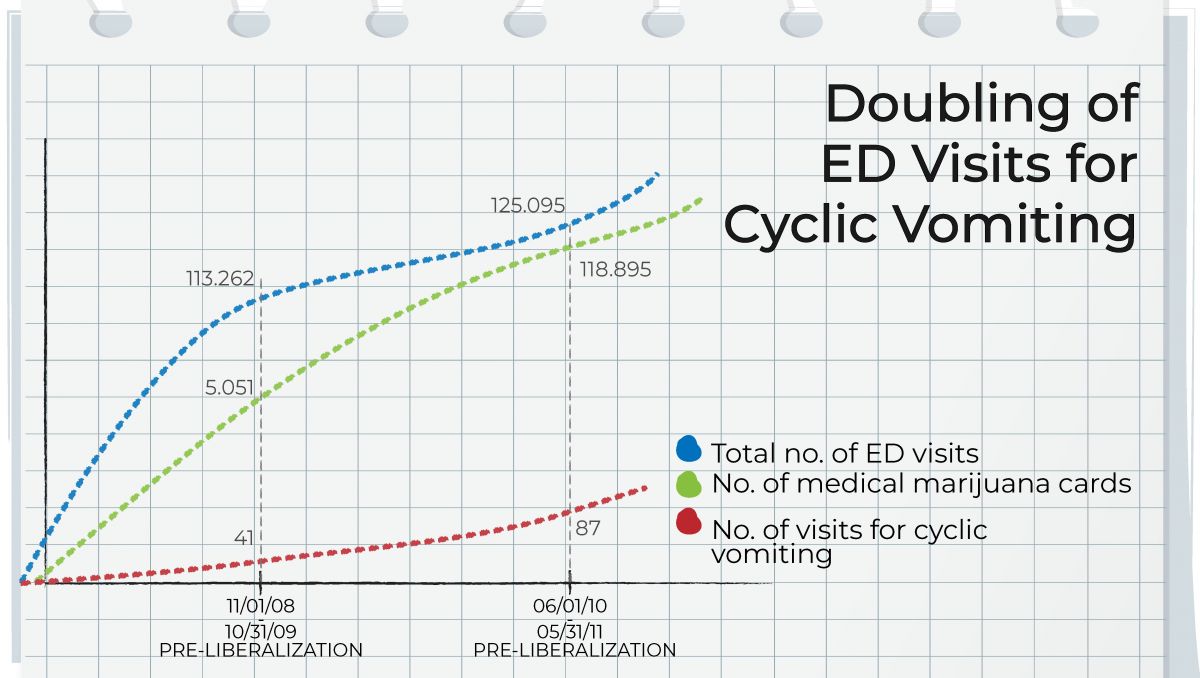
Regardless of whether this increase was factual or not, the percentage of episodic vomiting in the country had shown a rise of 17.9% over the rates prior to legalization, and, according to the Drug Abuse Warning Network (DAWN), the reported use of weed in medical records went up 21% between 2009 and 2011. 5 6
Ever since 2009, the reports of hyperemesis have shown a significant increase, and they continue to increase around 8% each year. In fact, these increments have been noted most especially in those states in the U.S. where marijuana has been legalized.
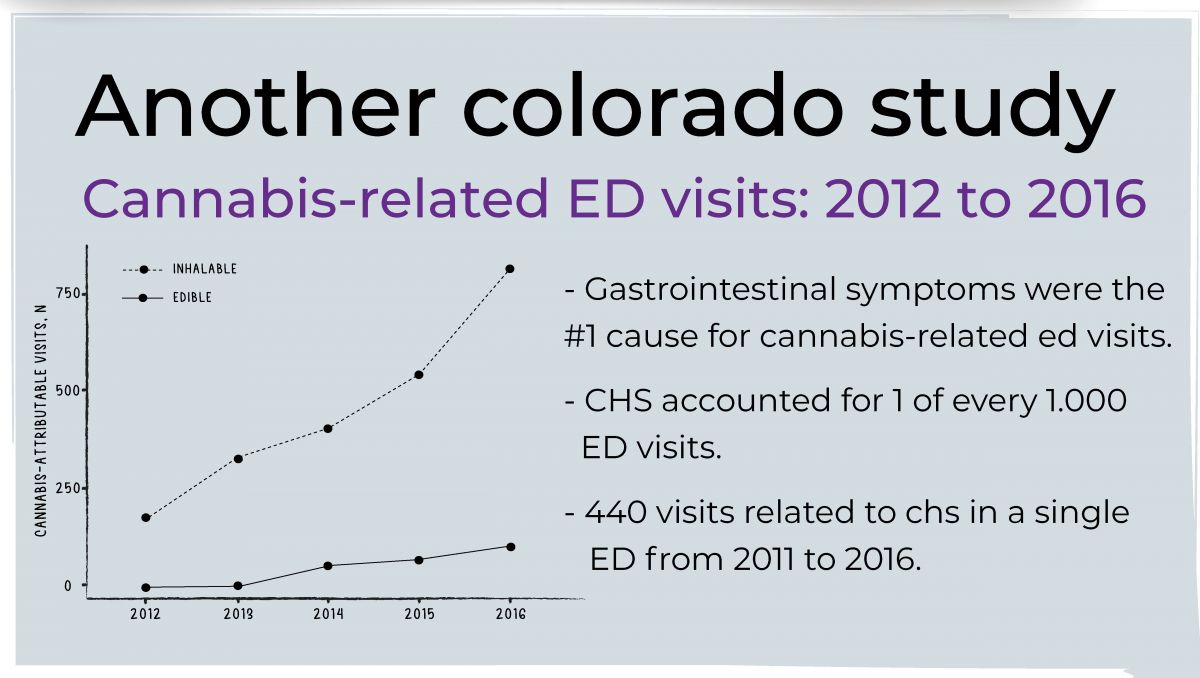
It is believed that this CHS condition that was once considered to be rare will emerge as a common side effect from long-term and heavy cannabis use in the near future as weed becomes legal in more countries around the world.
How Can Cannabinoid Hyperemesis Syndrome Be Diagnosed?
When it comes to the diagnosis of CHS, events can turn out in several different ways, depending on how well-informed the medical establishment and their doctors' team is. On one hand, a patient who may be suffering from CHS may have to undergo a vast amount of medical tests and studies before their condition is finally discovered. This is more likely to happen in places where cannabis use isn't yet widely accepted, and in cases where the patients are fearful of admitting their weed use.
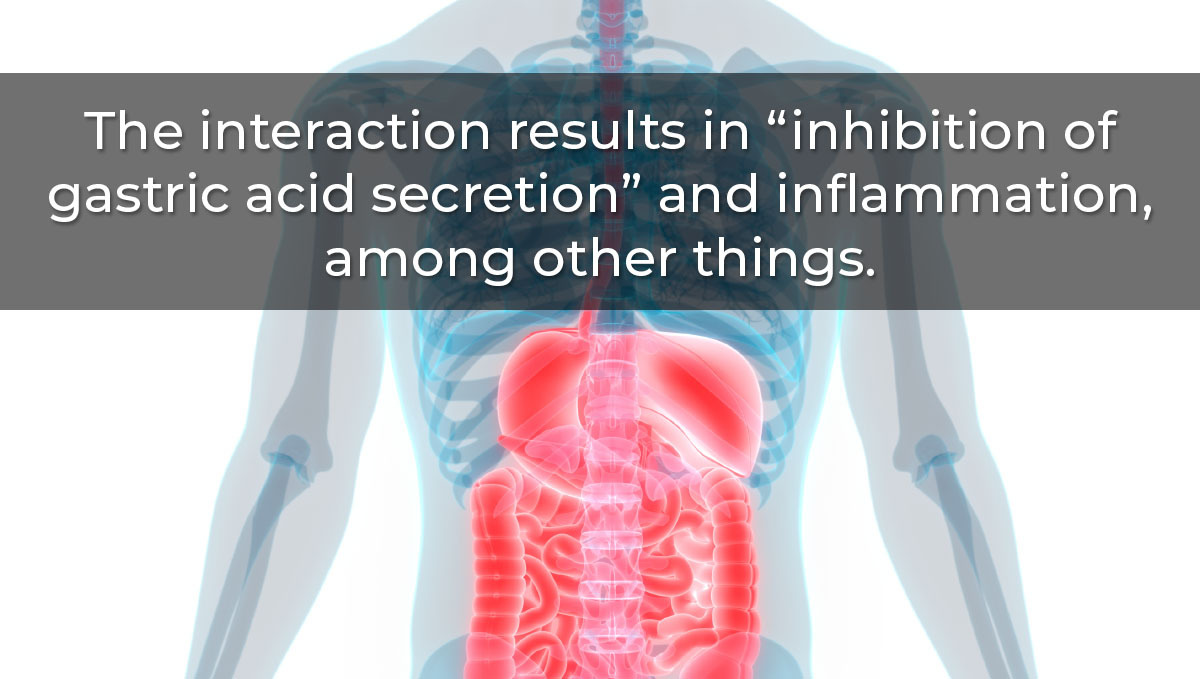
When this lack of information from either or both parts takes place, several tests will be needed to rule out the possibility that any other health affections are the reason behind the symptoms. Such medical tests include some of the following:
- Electrolytes tests;
- Blood tests for anemia or infections;
- Pancreas and liver enzymes tests;
- In the case for women, pregnancy tests;
- Abdominal x-rays and tests check for issues such as blockage;
- Upper endoscopies to check the esophagus and stomach for possible causes of vomiting;
- Head and abdominal CT to discard nervous system or other health problems involved with the vomiting;
- Urine analysis to check for infections;
- And drug screens, which may actually find effective results.
On the second hand, if a possible CHS patient is lucky enough to bump into well-informed doctors, or if he or she has informed themselves prior to the appointment, the diagnosis could skip some of the previous testings, and some talking may just do the job. Still, testing should ideally be done in order to prevent other conditions from going unnoticed.
4. Why Would Marijuana Cause Cannabinoid Hyperemesis Syndrome?
Now, one common thought concerning CHS is how come cannabis, which is so often used as a treatment for nausea and vomiting, produces the paradoxical effect of vomiting? Although much research needs yet to be done, there are a couple of theories and ideas why this might happen.
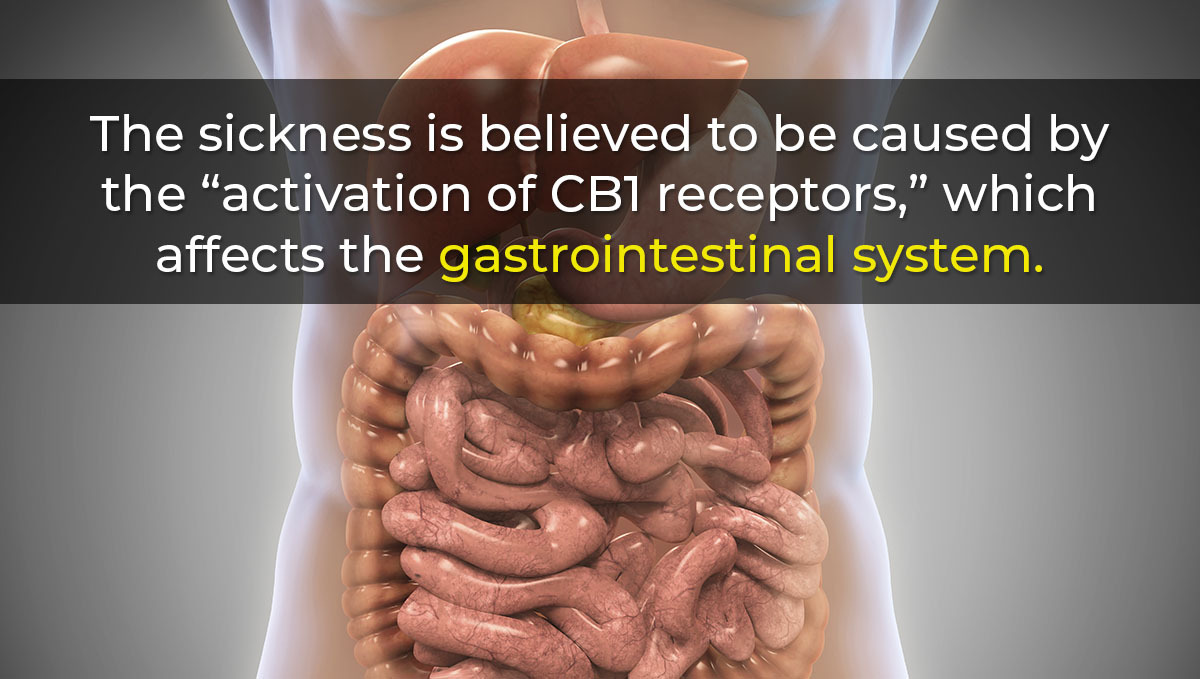
Marijuana, especially THC activates the CB1 receptors in our bodies, which could, in turn, produce a few of the following effects on the gastrointestinal system:
- Inflammation and visceral pain;
- Lower esophageal sphincter relaxation;
- The inhibition of gastric acid secretion;
- Decrease of gastric movement;
- And delay in gastric emptying.
However, this theory, that when THC is consumed heavily and over prolonged periods of time, it provides anti-emetic effects on the brain but disturbs our gut, it's just another one yet to be confirmed.
But THC isn't the only suspect in this Cannabinoid Hyperemesis Syndrome, otherwise it'd be called THC Hyperemesis Syndrome. Other studies, in both humans and animals, which we're not in favor of, found that other cannabinoids, including CBD and CBG, and the way they bind with each other can also produce either antinausea or vomiting effects, depending on the amounts consumed.
Opposed Thoughts On Existing Theories
When we take a look at opposing thoughts on these theories, the need for further research only stands out even more. A review published by a group of Australian investigators in 2006 really made us question what was the actual truth. 7
“Cannabis has been consumed for many centuries and is currently used by millions of people in many countries [...] It is hard to believe that a distinctive syndrome caused by cannabis has never been noted before by users or clinicians.”
There could be lots of truth in such statement, however, the researchers didn't go much further than that in their investigations to make an actual point and prove everyone else wrong.
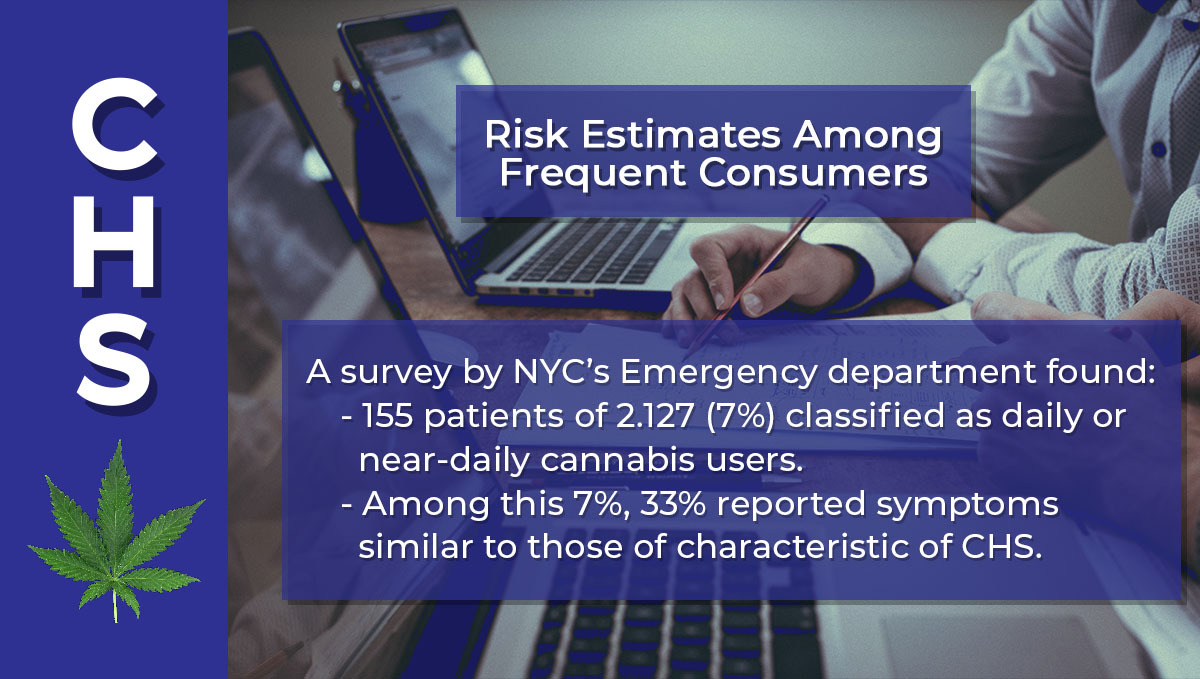
Further opposing thoughts consider that perhaps it is not actually the cannabis that is causing the aforementioned symptoms but rather the chemicals that the plants are grown and fed with. This theory could hold some truth since no cases of CHS have been reported in places such as India and Asia, where weed plants are grown solely with natural methods.
5. What Treatments Are There For Cannabinoid Hyperemesis Syndrome?
To this day, no medical treatments have been found for easing the symptoms of Cannabinoid Hyperemesis Syndrome. This means that, yes, and sadly for the stoners, the only measure now available to stop the nausea, vomiting and abdominal pain is to cease using marijuana in all of its forms.
After taking a halt in their weed use, the symptoms tend to decrease after the first 24 to 48 hours, unless the patients break their marijuana withdrawal before this period. Ceasing to use cannabis isn't a temporary but rather a definite solution to the disorder, as the symptoms may come back due to weed use even months or years later.
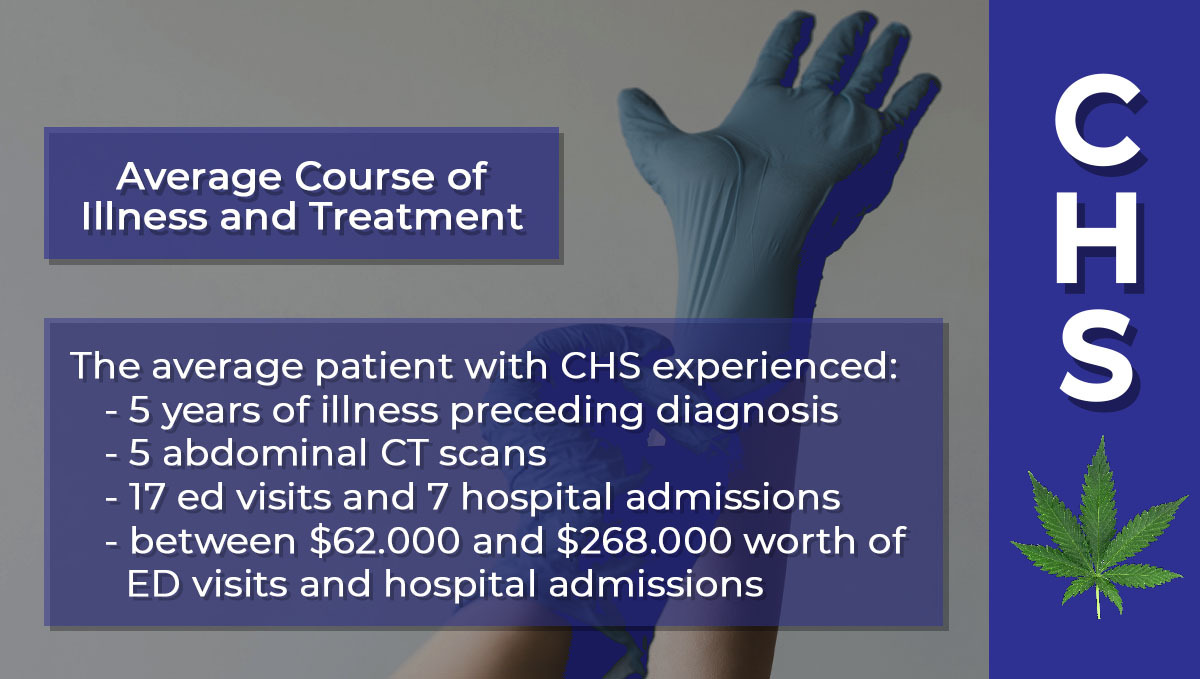
Short-term treatments to alleviate the symptoms on the spot include a couple of the ones listed below. Patients may also need to stay a couple of days under medical attention in a hospital.
- Taking a hot shower or bath;
- Intravenous fluid replacement to prevent dehydration;
- Medicines to help decrease vomiting, although not always effective;
- Analgesics to cope with the abdominal pain;
- Proton-pump inhibitors to reduce stomach inflammation;
- Rubbing capsaicin lotion or cream on the belly area to ease pain and decrease nausea;
- And benzodiazepine-based medicines to relax.
On one side, the person suffering from CHS will need to attend to the symptoms related to the illness, and at the same time regard other underlying issues that such disorder may cause. This includes supportive treatments such as electrolyte replacement to correct any possible imbalances caused by repetitive vomiting.
Why Do Hot Showers Help Ease CHS?
As you read how hot showers are reported to be the most effective treatment for CHS, you may be left wondering why exactly it is that this occurs. There are three different hypotheses as to why this may happen.
The first one believes that there are hypothermic psychoactive components contained in cannabinoids and that hot showers help regulate the users' core body temperature. The second one proposes that our CB1 receptors are located near the body's thermoregulation system in the hypothalamus and its direct warm water that aids in the regulation of body temperature. 8 9

The third hypothesis proposes that warm water could help direct blood flow away from the gut, to the periphery and skin, and therefore 'distract' the nauseous sensations. However, researchers don't seem all too convinced with these three theories, and a new one came up that seems to be far more promising.
This last theory proposes that at very high temperatures, over 43°C, or by binding with capsaicin, the TRPV1 ion channels open up, which then produce antiemetic effects on the body. Therefore, if a CHS patient manages to expose their TRPV1 channels to heat or capsaicin, they could achieve to fight the emesis, a.k.a. vomiting. 10 11
6. Is Cannabis Hyperemesis Syndrome Actually New?
Over the course of this article, and as we did our research, we've noted the emphasis on how this is only a recently discovered disorder. However as we dug in further, the fact is that this isn't entirely the truth.
The first proper report of CHS took place back in 2004 by J. H. Allen, along with a group of other investigators. Furthermore, in the 2002 book written by Mitch Earleywine, "Understanding Marijuana" the writer noted that Arab writings from the 11th century already evidenced these nauseous effects from cannabis.
"The regular use of hashish could lead to continuous retching and death" indicated the writings.
Last but not least, such side effects of vomiting and nausea were already warned on the prescribing information of Marinol. Marinol is the commercial name for dronabinol, a THC-based prescription medicine that was first approved by the FDA in 1985.
7. The Bottom Line
In order to make our conclusion concerning CHS we'll have to resort to one of philosophy's most famous statements:
"I know that I know nothing" Socrates, (470 – 399 BC)
Although it may sound like an innocent joke, the truth is that before anyone is diagnosed with any syndrome or disorder, shouldn't science, medicine or whichever field is in charge of such subjects be actually sure of what they're doing and saying?
Sadly, to this day we know just the tip of the iceberg concerning cannabis. There is yet so much more to learn concerning this plant and its possible benefits and side effects that no hypothesis should now be fully trusted unless the contrary is finally proven.
MEDICAL DISCLAIMER
This content is for educational purposes only. The information provided is derived from research gathered from external sources.
EXTERNAL REFERENCES
- "Cannabinoid Hyperemesis Syndrome" Jonathan A. Galli, Ronald Andari Sawaya, and Frank K. Friedenberg. December 2011.
- "Hyperemesis gravidarum and placental dysfunction disorders" Heleen M. Koudijs, Ary I. Savitri, Joyce L. Browne, Dwirani Amelia, Mohammad Baharuddin, Diederick E. Grobbee, and Cuno S. P. M. Uiterwaal.
- "Cannabinoid hyperemesis: cyclical hyperemesis in association with chronic cannabis abuse" J. H. Allen, G. M. de Moore, R. Heddle, and J. C. Twartz. November 2004.
- "Cannabinoid Hyperemesis Syndrome" Erik Messamore for 15-Minute Pharmacology on YouTube. May 2020.
- "Effects of the 2009 Medical Cannabinoid Legalization Policy on Hospital Use for Cannabinoid Dependency and Persistent Vomiting" Mustafa Al-Shammari, Karina Herrera, Xibei Liu, Brandon Gisi, Takashi Yamashita, Kyu-Tae Han, Mohamed Azab, Harmeet Mashiana, Muthena Maklad, Muhammad Talha Farooqui, Ranjit Makar, and Ji Won Yoo. American Gastroenterological Association (AGA), July 2017.
- "What is the scope of marijuana use in the United States?" National Institute on Drug Abuse (NIDA), updated July 2020.
- "Cannabis hyperemesis: causation questioned" A. Byrne, R.Hallinan, and A. Wodak. January 2006.
- "Cannabinoid hyperemesis syndrome: a case report and review of pathophysiology" Corina L. Iacopetti and Clifford D. Packer. March 2014.
- "Cannabinoid hyperemesis and compulsive bathing: a case series and paradoxical pathophysiological explanation" Dale A. Patterson, Emmaleigh Smith, Mark Monahan, Andrew Medvecz, Beth Hagerty, Lisa Krijger, Aakash Chauhan, and Mark Walsh. December 2010.
- "The functions of TRPA1 and TRPV1: moving away from sensory nerves" E. S. Fernandes, M. A. Fernandes, and J. E. Keeble. May 2012.
- "Resolution of cannabis hyperemesis syndrome with topical capsaicin in the emergency department: a case series" Laurel Dezieck, Zachary Hafez, Albert Conicella, Eike Blohm, Mark J O'Connor, Evan S. Schwarz and Michael E. Mullins. May 2017.













Comments